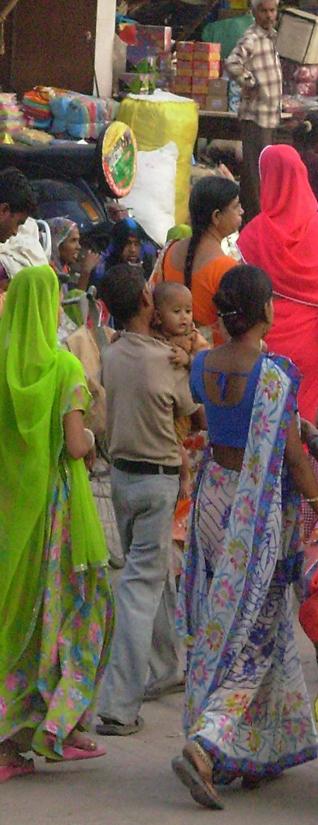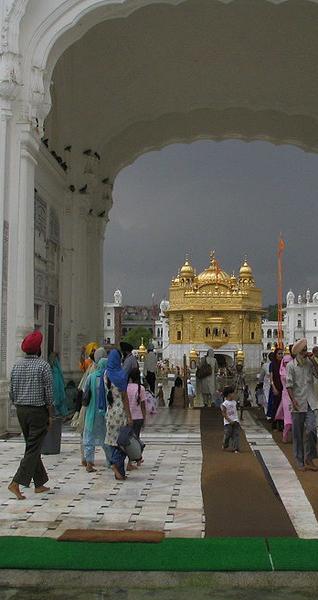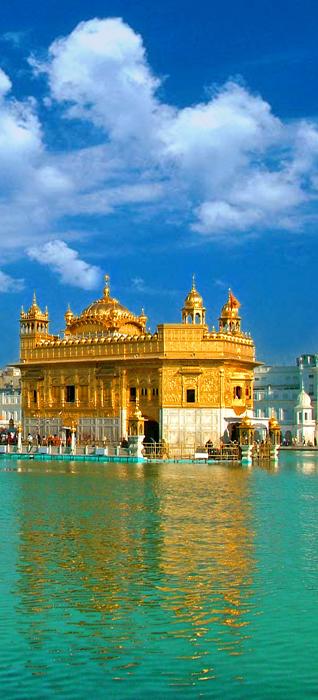Travel
Going Home
by RUPINDER KAUR DIGWA
What do holidays mean to you?
For me it was the chance to
return to the
place where my grandparents were born and grew up. It's where my
religion, Sikhism, started out. It was a journey that showed me the
importance of cultural identity, the sacrifices that people made that
enabled me to see the real Punjab and India.
Think India and images from Slum Dog Millionaire probably
come to mind:– a diverse mixture of extreme poverty, shanty towns and
rich fabrics. But amongst all the poverty, India is a country that
brings
light to the soul. The beauty of Punjab's cities and its people is a
real
escapism from the hectic ways of life.
We landed at the New
Dehli airport around 3 am.
We followed signs for customs to get our passports stamped. A stern looking man sat behind the desk. "Next!"” he said, as he slammed my passport down. I was hoping for a “welcome to India and a "How was your journey?"” or at least a smile.
The air smelt like a bonfire. We were looking hrough rows of people to see our relatives whom I had seen from only photographs. Bebe ji, my grandma's sister, and her husband were supposed to collect us from the airport. People were shouting and waving signs. They would stare at every 'foreigner' who walked through, as if they were aliens. I was surprised they could tell that we were the 'angrejhees' - the English.
Bebe
ji greeted
us with garlands made out of pink carnation flowers.
The hotel
where we stayed for most of our holiday was in the heart
of the city centre. It was opposite a cinema. There were also
dhabhas - small food stalls - selling paraunthas, samosas and aaloo
tikkis. There
were also a McDonald's, KFC, and Pizza Hut nearby, in case we missed
food from back home.
Though the experience in the local
McDonald's was somewhat
different to that in the U.K. They do not sell beef or pork that
are prohibited by the Hindu and Muslim religions, respectively. [But
then, shouldn't they have a McDonalds's for Sikhs?] Only the wealthy,
mostly
families and the young and educated were allowed to eat and work there. A
security guard stood at the entrance making sure the restaurant
maintained its standards.
The next day we hit the main shopping
market. Tilak Nagar is a 15-minute scooter-rickshaw ride from the hotel.
It was
a sea of colours - red, green, yellow, purple, orange - you name it, it
was
there. The handmade stitching was even more striking - jerkins with diamond-like stones,
sequins ... I wanted to buy everything.
Though the constant hassling from shop keepers was getting annoying.“ "English Madam, look beautiful ... only 700 rupee!"
However, their customer service skills were fantastic. They
would order you a drink, have knowledge of every single item they sold.
They would even make you stand on a cushion which was positioned right
under a light, switch the fan on, “smile .."Beautiful, absolutely
beautiful!". Okay, they wanted me to spend my money but it made shopping
even more worth it.
Having spent most of the morning
shopping, we finally stopped for some lunch at a restaurant. The
mixture of spices smelled so good. They served a range of authentic Punjabi savoury and sweet foods. I ordered the popular classic channa
bhatura, which is chick peas marinated in sauce, with a
blend of mouth watering spices, served with the bhatura, which is a seasoned
fried chapatti. And I had the scrumptious gulab jamun for dessert.
The
next few days were spent visiting other major cities. Our
first stop was Jaipur, a main tourist attraction. The architecture of the
buildings was mesmerizing. My favourite had to be Hawa-Mahal built in
the 18th century by Maharaja Pratap Singh. It is a pink sandstone
structure which is five stories high. It is covered with little windows
with lace screens to let the wind blow through the passages, which is why
it's been given the name 'hawa' which means wind. It served as a
grandstand for the royal ladies.
We also visited the captivating city palace. The design of the architecture was a mixture of Rajasthani and Mughal style. The interior was coated with little mirrors. When the hall way is closed it creates a large diamond shape. The palace was built by Raja Sawa Singh - it was used to serve the royal guests. Jaipur was definitely a city which had great beauty and a strong cultural history which still remains today. The traditional Rajasthani clothing was most prominent. It was an extraordinary feature of the land.
Our final trip was to Amritsar in the Punjab to visit Harmandar Sahib, 'The Golden Temple'. This had to be my most special and memorable experience of our trip to India.
It gave me a real understanding of my cultural and religious
roots. Visiting Harmandar Sahib is important - all
Sikhs should do it. Amritsar is a sacred city to Sikhs not only because
of the Golden Temple, but the fact that Sikh identity began here. The
construction of the building began in 1574 by the fourth Sikh Guru, Ram Das. In the 1800s, Maharaja Ranjit Singh contributed the gold
and the marble work.
However, over the years Sikhs have fought and
sacrificed their lives defending against Moghul and Afghan invaders who have tried
to destroy the temple. In more recent times, during the 1984 Blue Star attack,
orders were given to the Indian army to take tanks in and fire at the pilgrims. Many parts
of the building were destroyed and thousands of innocent Sikh men, women and children were killed by evil Mrs. Gandhi's troops.
Harmandar Sahib
is still a peaceful and safe place to visit. It welcomes people from
all religions, creeds and cultures. As soon as I entered, I felt an
instant warm feeling inside. It was breath-taking! The golden shrine
glistened and reflected on the pool of nectar. Beautiful hymns rang
through my ears and I could smell 'langar' - the food being being prepared in the communirty kitchen.
It was a magical moment.
I was at peace.
[Rupinder is a student journalist at Southampton Solent University.]
[Courtesy: The Mail]
March 22, 2010
Conversation about this article
1: Taran (London, United Kngdom), March 22, 2010, 12:31 PM.
Can't understand though that you visit India and get connected to your culture and religion instantly. Also before leaving the shores of U.K., you can see a trailer in the towns of Southall, Hounslow or in Soho Road Birmingham. When I came from Chandigarh ten years ago to join my family here, I couldn't believe my eyes. I have visited a few places in Punjab but the Punjab in India is so much ahead than the Punjab here in U.K.
2: Sangat Singh (Kuala Lumpur, Malaysia), March 22, 2010, 7:34 PM.
India remains somewhat amorphous and complies with any shape you want to, according to your mood and perception. It was born to power, war and glory, and more importantly, a land blessed with the Gurus, rishis and saints of all denominations, to impart it their Timeless Wisdom. Of course, if you choose to be baffled, infuriated or amused, it depends on your own mood. There is always a surfeit of visible hustle and bustle of piety and prayer, but nothing beats the serene atmosphere of the Harmandar Sahib in Amritsar. The moment you cross the threshold of the Darshni Deorhi, you are in His Presence, and it never fails in its magic. "Ditthay sabhay thaav nahi tud jayh-aa" - "I have seen all places, but none can compare to you." I hope, Rupinder, you found it such.





